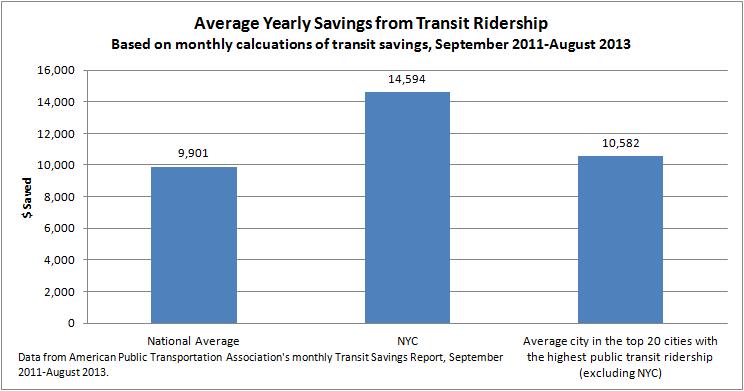It’s generally accepted that taking public transportation saves money. But just how much?
The American Public Transportation Association’s monthly Transit Savings Report quantifies how much money per month a typical individual saves by choosing public transportation over driving. APTA’s analysis relies on a number of assumptions, such as:
- drivers have to pay for monthly parking;
- drivers drive an average of 15,000 miles per year;
- public transportation users only have to buy one monthly transit pass (not, for example, a monthly MetroCard and a monthly Metro-North ticket); and
- public transportation users have no driving costs.
Nonetheless, the Transit Savings Report finds that using transit and “living with one less car” can save a striking amount of money.
TSTC crunched two years of data and found:
- New York City residents
- Average monthly savings: $1,216
- From September 2012-August 2013: $14,691 in savings
- From September 2011-August 2012: $14,497 in savings
- Though New York City residents have had the highest savings of all the cities considered by APTA (the organization examines the top 20 cities with the highest public transit ridership), there are considerable savings for residents in the 19 other cities as well. Averaging the savings of the 19 other cities:
- Average monthly savings: $882
- From September 2012-August 2013: $10,548 in savings
- From September 2011-August 2012: $10,615 in savings
- Average nation-wide:
- Average monthly savings: $825
- From September 2012-August 2013: $9,935 in savings
- From September 2011-August 2012: $9,867 in savings
The analysis bolsters findings from the Center for Neighborhood Technology which has shown the importance in connecting housing and transportation costs to better understand neighborhood affordability. CNT’s H+T Index makes clear that when transportation costs are included into determining housing affordability, some “inexpensive” areas become considerably more costly to live in, while some “expensive” areas that have access to public transportation become more affordable.
According to APTA’s data, between September 2012 and August 2013 New York City residents taking public transit instead of driving saved an average of $1,224 per month. However, these savings may shrink if the MTA continues to raise fares.
APTA’s calculations are based on the cost of commuting by public transportation (the cost of a monthly transit pass), the cost of owning and driving a vehicle (which is from the AAA’s cost of driving formula and includes gas, maintenance, license and registration fees), as well as gas prices and the unreserved monthly parking rate.
To find out your potential transportation cost savings, visit APTA’s website and play with their calculator.



Does the transit user bear the same percentage of total costs of trip that the automobile user does? Does the transit user cover the cost of buying, maintaining, insuring and fueling the bus let alone the cost of the driver and maintaining it? The transit user gets at least the same amount of road subsidy that the automobile user does. Parking is subsidized for both to at least some extent. Does the taxpayer come out ahead when people take transit in terms is less total net government expenditure? This is purely a question of which trip costs the general taxpayer more and how is that answer substantiated?
The taxpayer also pays the costs for roads, traffic enforcement and policing. I do not have any figures, but I strongly suspect that when you take all the costs into consideration, public subsidies for auto travel are greater than for public transit.
On top of this, we also need to consider other hidden costs of our auto-centric transportation. Traffic fatalities are the number one cause of death in this country. Acid rain is causing deterioration of buildings and other infrastructure, not to mention the environmental damage. Pollution leads to increased mortality and morbidity. And let’s not forget about ocean acidification and global climate change from CO2 emissions.
Any road subsidy including traffic enforcement and on street parking is also given to the bus rider with bus stops being the equivalent of parking. To the extent that off street parking is subsidized that has to be balanced by off street transit terminals that are tax exempt. Buses also are involved in accidents. Remember that in most jurisdictions in the state and probably even in the outer boroughs transit trips are far fewer than automobile trips.
[…] Nonetheless, the Transit Savings Report finds that using transit and “living with one less car” can save a striking amount of money. {…} […]
[…] transit network in place, this is all the more reason for Nassau and Suffolk Counties to capitalize on that network by investing in interconnectivity of transportation options and […]